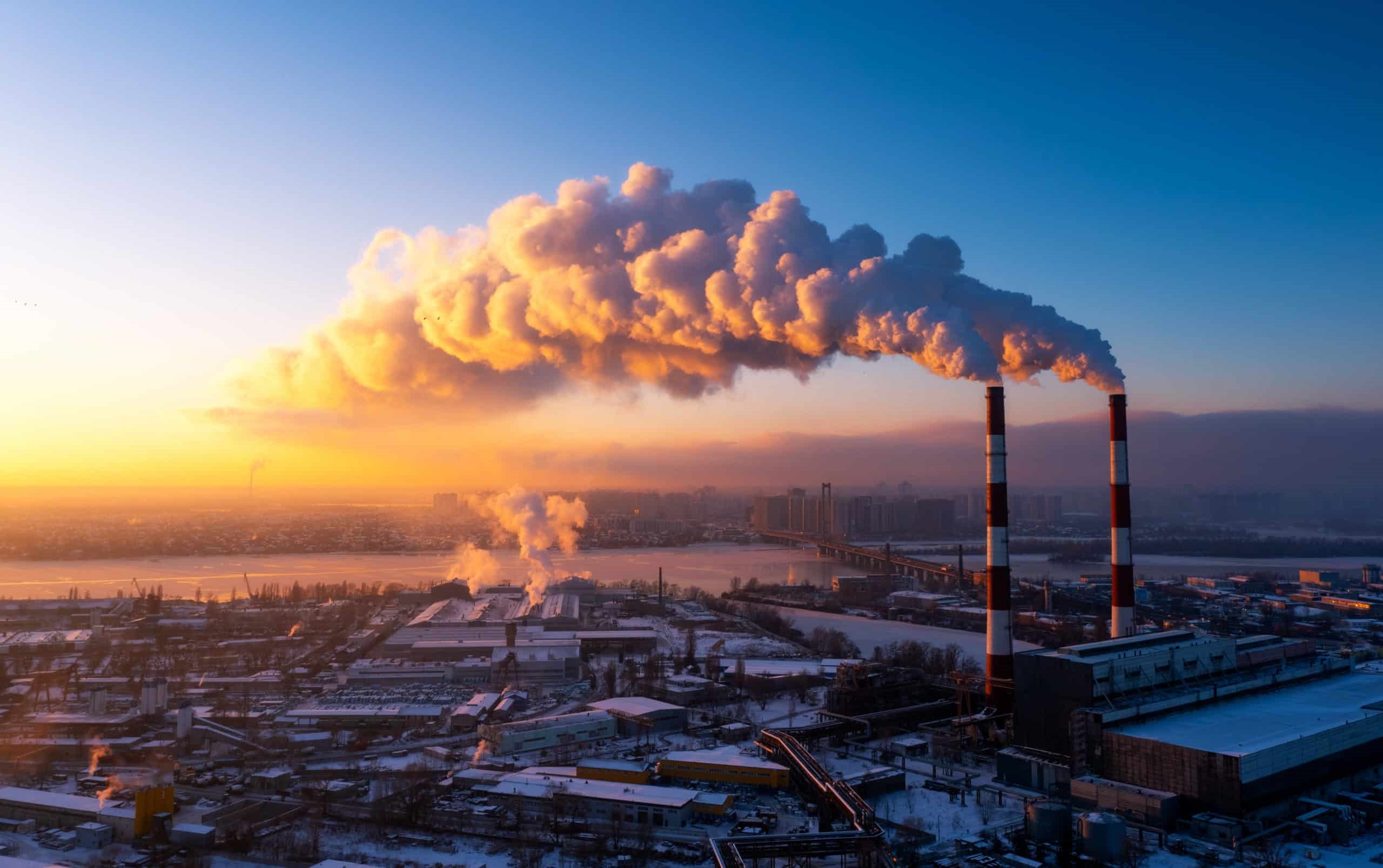Home>Weather and Climate>Understanding Greenhouse Gases: Causes, Effects, And Solutions


Weather and Climate
Understanding Greenhouse Gases: Causes, Effects, And Solutions
Published: March 4, 2024
Learn about the causes, effects, and solutions of greenhouse gases on weather and climate. Understand the impact and ways to mitigate their effects.
(Many of the links in this article redirect to a specific reviewed product. Your purchase of these products through affiliate links helps to generate commission for Temperatures.com, at no extra cost. Learn more)
Table of Contents
Introduction
Greenhouse gases play a pivotal role in shaping the Earth's climate and are a crucial aspect of our planet's delicate balance. These gases, including carbon dioxide, methane, nitrous oxide, and fluorinated gases, act as a natural blanket, trapping heat from the sun and maintaining a habitable temperature for life on Earth. However, the excessive accumulation of greenhouse gases due to human activities has led to a phenomenon known as the enhanced greenhouse effect, resulting in global warming and climate change.
Understanding the dynamics of greenhouse gases is essential for comprehending the intricate web of interactions that govern our planet's climate system. By delving into the causes, effects, and potential solutions related to greenhouse gases, we can gain valuable insights into the environmental challenges we face and the actions needed to mitigate their impact.
The intricate relationship between greenhouse gases and climate change has garnered significant attention in recent years, as the consequences of a warming planet become increasingly evident. From rising sea levels and extreme weather events to shifts in ecosystems and disruptions in agricultural patterns, the effects of greenhouse gas-induced climate change reverberate across the globe, impacting both natural and human systems.
As we navigate the complexities of greenhouse gases and their implications, it becomes apparent that addressing this issue requires a multifaceted approach, encompassing scientific research, technological innovation, policy interventions, and collective societal action. By fostering a deeper understanding of greenhouse gases and their role in climate change, we can pave the way for informed decision-making and proactive measures aimed at safeguarding the planet for future generations.
In the subsequent sections, we will delve into the science behind greenhouse gases, explore their sources, examine their far-reaching effects on the environment and human health, and consider the array of solutions and international efforts aimed at mitigating their impact. Through this exploration, we aim to unravel the complexities of greenhouse gases and illuminate the pathways toward a more sustainable and resilient future for our planet.
Read more: The Role And Impact Of Greenhouse Gases
The Science Behind Greenhouse Gases
Greenhouse gases are integral to the Earth's climate system, playing a pivotal role in regulating the planet's temperature and overall climate. These gases possess unique properties that allow them to trap heat in the atmosphere, thereby contributing to the greenhouse effect. The greenhouse effect is a natural phenomenon that enables the Earth to maintain a relatively stable and hospitable climate, essential for supporting life as we know it.
At the core of the greenhouse effect lies the ability of certain gases to absorb and re-emit infrared radiation, a type of heat energy emitted by the Earth's surface. When sunlight reaches the Earth, it warms the surface, which then emits infrared radiation. Greenhouse gases, such as carbon dioxide (CO2), methane (CH4), nitrous oxide (N2O), and fluorinated gases, effectively trap a portion of this infrared radiation within the atmosphere, preventing it from escaping into space. As a result, the lower atmosphere retains more heat, leading to an overall warming effect.
The fundamental mechanism behind the greenhouse effect can be likened to the function of a blanket: just as a blanket traps and retains body heat, greenhouse gases trap and retain heat within the Earth's atmosphere. This process is crucial for maintaining a habitable climate, as it prevents the Earth from becoming excessively cold. However, human activities, particularly the burning of fossil fuels, deforestation, and industrial processes, have significantly increased the concentration of greenhouse gases in the atmosphere, amplifying the natural greenhouse effect and contributing to global warming.
The concept of greenhouse gases and their role in climate regulation is rooted in the principles of radiative transfer and atmospheric physics. These gases interact with incoming solar radiation and outgoing infrared radiation, influencing the energy balance of the Earth-atmosphere system. Through this intricate interplay, greenhouse gases shape the Earth's energy budget, determining the distribution of heat across the planet and influencing regional climate patterns.
By comprehending the underlying science of greenhouse gases, we can grasp the mechanisms driving climate change and the potential ramifications of altering the delicate balance of atmospheric composition. This understanding forms the foundation for devising strategies to mitigate greenhouse gas emissions, adapt to climate change, and foster sustainable practices that promote a harmonious coexistence with the natural world.
Sources of Greenhouse Gases
The sources of greenhouse gases are diverse and encompass a wide array of human activities and natural processes. Understanding these sources is crucial for identifying opportunities to mitigate emissions and address the underlying drivers of climate change. The primary sources of greenhouse gases can be categorized into both anthropogenic (human-caused) and natural origins, each contributing to the complex dynamics of atmospheric composition and climate regulation.
Anthropogenic Sources
-
Fossil Fuel Combustion: The combustion of fossil fuels, including coal, oil, and natural gas, for energy production, transportation, and industrial processes is a leading contributor to greenhouse gas emissions. The release of carbon dioxide (CO2) from these activities significantly augments the atmospheric concentration of this potent greenhouse gas.
-
Deforestation and Land Use Changes: The clearing of forests for agriculture, urban development, and other land use changes releases carbon stored in trees and soil into the atmosphere. This process contributes to elevated CO2 levels and diminishes the Earth's capacity to sequester carbon, exacerbating the greenhouse effect.
-
Industrial Processes: Various industrial activities, such as cement production, chemical manufacturing, and waste management, release greenhouse gases, including carbon dioxide, methane, and fluorinated gases, as byproducts of production and waste disposal.
-
Agricultural Practices: Agricultural operations, particularly livestock farming and rice cultivation, are significant sources of methane and nitrous oxide emissions. Enteric fermentation in ruminant animals and the use of nitrogen-based fertilizers contribute to the release of these potent greenhouse gases.
Natural Sources
-
Biological Processes: Natural biological processes, such as decomposition of organic matter, wildfires, and volcanic eruptions, release greenhouse gases into the atmosphere. Methane emissions from wetlands and termites, as well as natural sources of nitrous oxide, play a role in the natural carbon and nitrogen cycles.
-
Oceanic Processes: The world's oceans serve as a crucial reservoir of carbon dioxide, absorbing and releasing this greenhouse gas through natural processes. Oceanic emissions of CO2, as well as the release of methane from marine sediments, contribute to the natural flux of greenhouse gases in the atmosphere.
By comprehensively examining the sources of greenhouse gases, we gain insight into the diverse origins of these emissions and the interconnectedness of human activities and natural systems in shaping the Earth's climate. Addressing these sources requires a multifaceted approach, encompassing sustainable energy practices, land use management, technological innovation, and international cooperation to mitigate emissions and foster a more resilient and balanced global environment.
The Effects of Greenhouse Gases on the Environment
The accumulation of greenhouse gases in the Earth's atmosphere has profound and far-reaching effects on the environment, exerting significant impacts across various ecological systems and natural processes. These effects manifest in a multitude of ways, influencing climate patterns, biodiversity, and the overall stability of ecosystems.
Climate Change and Extreme Weather Events
One of the most notable consequences of heightened greenhouse gas concentrations is the alteration of global climate patterns. The Earth's average temperature has risen, leading to shifts in weather phenomena and an increase in the frequency and intensity of extreme weather events. Heatwaves, droughts, intense storms, and heavy precipitation events have become more prevalent, posing risks to human communities, agriculture, and infrastructure.
Melting Glaciers and Rising Sea Levels
The warming induced by greenhouse gases has accelerated the melting of glaciers and ice sheets, contributing to rising sea levels. This phenomenon poses a threat to coastal regions and low-lying islands, leading to coastal erosion, inundation of land, and salinization of freshwater sources. The displacement of communities and loss of vital ecosystems are among the repercussions of sea level rise.
Disruption of Ecosystems and Species Distribution
Changes in temperature and precipitation patterns, driven by greenhouse gas-induced climate change, have disrupted ecosystems and altered the distribution of plant and animal species. Shifts in habitat suitability, phenological events, and migration patterns have implications for biodiversity conservation and ecological balance, potentially leading to the loss of species and the destabilization of ecological interactions.
Ocean Acidification and Coral Bleaching
The absorption of excess carbon dioxide by the world's oceans has led to ocean acidification, impacting marine life and coral reef ecosystems. Acidification poses a threat to shell-forming organisms and disrupts marine food webs, while rising sea surface temperatures contribute to coral bleaching, endangering the intricate biodiversity harbored within coral reef systems.
Agricultural Impacts and Food Security
Changes in temperature and precipitation regimes affect agricultural productivity and food security, with implications for global food systems. Shifts in growing seasons, water availability, and the prevalence of pests and diseases pose challenges to crop yields and livestock production, potentially exacerbating food insecurity in vulnerable regions.
Feedback Mechanisms and Tipping Points
The effects of greenhouse gases on the environment can trigger feedback mechanisms and tipping points, leading to self-reinforcing cycles of climate change. These phenomena, such as the release of methane from thawing permafrost and the reduction of ice albedo, have the potential to amplify the impacts of global warming, further exacerbating environmental disruptions.
In summary, the effects of greenhouse gases on the environment are multifaceted and interconnected, influencing a wide array of natural systems and ecological processes. Understanding these effects is essential for devising strategies to mitigate emissions, adapt to climate change, and safeguard the resilience of ecosystems and human societies in the face of environmental challenges.
Human Health Impacts of Greenhouse Gases
The ramifications of greenhouse gases extend beyond environmental disruptions, significantly impacting human health and well-being. The complex interplay between climate change, air quality, and ecological transformations engender a myriad of health risks, posing challenges to public health systems and vulnerable populations worldwide.
Air Quality and Respiratory Health
Elevated levels of greenhouse gases contribute to the formation of ground-level ozone and fine particulate matter, which are detrimental to respiratory health. These air pollutants, often exacerbated by warmer temperatures and stagnant atmospheric conditions, can exacerbate respiratory conditions such as asthma and chronic obstructive pulmonary disease (COPD). Additionally, prolonged exposure to poor air quality is linked to increased cardiovascular morbidity and mortality, posing significant risks to individuals with pre-existing heart conditions.
Vector-Borne Diseases and Infectious Risks
The changing climate patterns influenced by greenhouse gases have implications for the distribution and prevalence of vector-borne diseases such as malaria, dengue fever, and Lyme disease. Shifts in temperature and precipitation regimes can alter the geographic range of disease-carrying vectors, potentially exposing new populations to infectious risks. Furthermore, extreme weather events and flooding associated with climate change can facilitate the spread of waterborne diseases, posing health threats to communities lacking access to safe drinking water and sanitation.
Heat-Related Illnesses and Vulnerable Populations
Rising temperatures driven by greenhouse gases elevate the risk of heat-related illnesses, particularly among vulnerable populations such as the elderly, children, and individuals with limited access to cooling resources. Heatwaves, intensified by the urban heat island effect, can lead to heat exhaustion, heatstroke, and exacerbation of pre-existing health conditions. The urban poor and marginalized communities often face heightened susceptibility to heat-related health impacts due to inadequate housing, limited green spaces, and socioeconomic disparities.
Mental Health and Psychosocial Stressors
The pervasive effects of climate change, influenced by greenhouse gas emissions, can engender psychosocial stressors and mental health challenges. Disruptions to livelihoods, displacement due to extreme weather events, and uncertainty regarding future environmental conditions contribute to anxiety, depression, and post-traumatic stress disorder (PTSD) among affected populations. The compounding effects of environmental degradation and climate-induced disruptions on mental well-being underscore the intricate relationship between human health and the changing climate.
Vulnerable Communities and Environmental Justice
It is crucial to recognize that the health impacts of greenhouse gases disproportionately affect marginalized and disadvantaged communities, perpetuating environmental injustices. Socioeconomic disparities, inadequate access to healthcare, and limited resources for climate adaptation render certain populations more susceptible to the health burdens imposed by climate change. Addressing these disparities and fostering equitable approaches to climate resilience and public health interventions are essential for mitigating the human health impacts of greenhouse gases.
In essence, the human health impacts of greenhouse gases underscore the intricate nexus between environmental changes and public health, necessitating comprehensive strategies to safeguard vulnerable populations, mitigate air pollution, and foster resilience in the face of a changing climate. By addressing the health implications of greenhouse gas-induced climate change, we can strive towards a healthier, more equitable future for all individuals and communities.
Solutions to Reduce Greenhouse Gas Emissions
Addressing the challenge of reducing greenhouse gas emissions necessitates a comprehensive and concerted effort across various sectors of society. From embracing renewable energy sources to implementing sustainable land use practices, a spectrum of solutions exists to mitigate emissions and foster a more sustainable trajectory for the planet. These solutions encompass technological innovation, policy interventions, and individual actions, collectively contributing to the global endeavor to combat climate change.
-
Transition to Renewable Energy: Embracing renewable energy sources, such as solar, wind, and hydroelectric power, is pivotal in reducing reliance on fossil fuels and curbing carbon emissions from electricity generation. Advancements in renewable energy technologies, coupled with supportive policies and investment incentives, can accelerate the transition towards a low-carbon energy landscape.
-
Energy Efficiency Measures: Implementing energy efficiency measures across industrial, residential, and commercial sectors can significantly reduce energy consumption and associated greenhouse gas emissions. From energy-efficient appliances and lighting to building retrofits and smart grid technologies, enhancing energy efficiency represents a cost-effective approach to curbing emissions while promoting sustainable development.
-
Sustainable Transportation: Promoting sustainable transportation solutions, including electrification of vehicles, expansion of public transit systems, and investment in non-motorized transport infrastructure, can mitigate emissions from the transportation sector. Shifting towards low-emission and fuel-efficient modes of transportation is essential for decarbonizing the mobility sector and improving air quality in urban areas.
-
Reforestation and Afforestation: Investing in reforestation efforts and afforestation initiatives can sequester carbon dioxide from the atmosphere, contributing to carbon sinks and biodiversity conservation. Restoring degraded landscapes and expanding forest cover play a crucial role in offsetting emissions and enhancing ecosystem resilience.
-
Carbon Capture and Storage (CCS): Deploying carbon capture and storage technologies in industrial processes and power generation facilities can mitigate emissions by capturing CO2 before it is released into the atmosphere and storing it underground. CCS represents a viable approach to reducing emissions from industrial sources and facilitating the transition to a low-carbon economy.
-
Circular Economy Practices: Embracing circular economy principles, including recycling, waste reduction, and sustainable resource management, can minimize emissions associated with resource extraction, production, and disposal. Promoting a circular approach to material flows and waste management contributes to emissions reduction and resource conservation.
-
Climate-Friendly Agriculture: Implementing climate-smart agricultural practices, such as agroforestry, conservation agriculture, and precision farming, can enhance soil carbon sequestration and reduce emissions from agricultural activities. Sustainable land management and agricultural innovations play a pivotal role in mitigating methane and nitrous oxide emissions while bolstering food security.
-
International Cooperation and Policy Frameworks: Fostering international cooperation and implementing robust policy frameworks, such as carbon pricing mechanisms, emissions trading systems, and regulatory standards, is essential for driving emissions reductions at a global scale. By aligning national commitments with the objectives of the Paris Agreement, countries can work collaboratively to limit global temperature rise and mitigate the impacts of climate change.
By embracing these solutions and fostering a collective commitment to sustainability, societies can embark on a path towards a low-carbon future, characterized by resilience, innovation, and environmental stewardship. The pursuit of emissions reduction strategies represents a pivotal opportunity to address the challenges of climate change while advancing a sustainable and equitable future for generations to come.
Policy and International Efforts to Address Greenhouse Gases
Policy and international efforts to address greenhouse gases are pivotal in shaping the global response to climate change and fostering collective action towards emissions reduction and climate resilience. At the international level, multilateral agreements and frameworks serve as cornerstones for coordinating efforts to mitigate greenhouse gas emissions and adapt to the impacts of a changing climate. The Paris Agreement, adopted in 2015 under the United Nations Framework Convention on Climate Change (UNFCCC), represents a landmark accord that unites nations in their commitment to limiting global temperature rise and enhancing climate resilience.
The Paris Agreement outlines a collective goal to hold the increase in global average temperature to well below 2 degrees Celsius above pre-industrial levels, with efforts to limit the temperature increase to 1.5 degrees Celsius. This ambitious objective necessitates the implementation of nationally determined contributions (NDCs), wherein each participating country outlines its emission reduction targets, adaptation measures, and climate finance commitments. By fostering transparency, accountability, and ambition, the Paris Agreement catalyzes a global endeavor to address the challenges posed by greenhouse gas-induced climate change.
Furthermore, international initiatives such as the Kyoto Protocol and the Clean Development Mechanism have laid the groundwork for emissions reduction and sustainable development cooperation among nations. These mechanisms facilitate emissions trading, technology transfer, and capacity-building efforts, fostering collaboration and knowledge exchange to advance low-carbon development pathways.
At the national and regional levels, governments and regulatory bodies play a pivotal role in enacting policies and regulations aimed at reducing greenhouse gas emissions and promoting sustainable practices. Carbon pricing mechanisms, such as carbon taxes and emissions trading systems, incentivize emissions reductions and provide economic signals for transitioning towards low-carbon technologies and practices. Additionally, regulatory standards for energy efficiency, emissions limits, and renewable energy deployment contribute to shaping a conducive environment for emissions mitigation and clean energy adoption.
Moreover, international partnerships and initiatives, such as the United Nations Sustainable Development Goals (SDGs) and the Intergovernmental Panel on Climate Change (IPCC), serve as platforms for scientific collaboration, knowledge dissemination, and advocacy for climate action. These initiatives underscore the interconnected nature of sustainable development and climate resilience, emphasizing the imperative of addressing greenhouse gas emissions within the broader context of environmental stewardship, social equity, and economic prosperity.
By fostering a robust policy framework and engaging in international cooperation, nations can collectively advance the agenda of emissions reduction, climate adaptation, and sustainable development. The integration of climate considerations into policy planning, investment strategies, and development agendas is essential for steering societies towards a resilient and low-carbon future, underpinned by a commitment to environmental integrity and global solidarity.
Conclusion
In conclusion, the intricate dynamics of greenhouse gases and their profound impact on the environment, human health, and global climate systems underscore the urgency of addressing the challenges posed by emissions accumulation. The science behind greenhouse gases elucidates the fundamental mechanisms driving climate change, emphasizing the need for comprehensive strategies to mitigate emissions and foster climate resilience. From the sources of greenhouse gases to their multifaceted effects on ecosystems, the implications of heightened greenhouse gas concentrations permeate diverse facets of the natural world, necessitating a holistic approach to emissions reduction and sustainable development.
The human health impacts of greenhouse gases underscore the interconnectedness of environmental changes and public health, highlighting the imperative of safeguarding vulnerable populations and fostering equitable approaches to climate resilience. The solutions to reduce greenhouse gas emissions encompass a spectrum of technological, policy, and behavioral interventions, offering pathways towards a low-carbon future characterized by innovation, sustainability, and environmental stewardship. By embracing renewable energy, enhancing energy efficiency, and promoting sustainable land use practices, societies can embark on a trajectory towards emissions reduction and climate adaptation.
Policy and international efforts to address greenhouse gases play a pivotal role in shaping the global response to climate change, fostering collective action towards emissions reduction and climate resilience. The Paris Agreement and other multilateral frameworks provide a foundation for international cooperation, transparency, and ambition in addressing the challenges posed by greenhouse gas-induced climate change. At the national and regional levels, regulatory standards, carbon pricing mechanisms, and sustainable development initiatives contribute to shaping a conducive environment for emissions mitigation and clean energy adoption.
As we navigate the complexities of greenhouse gases and their implications, it becomes evident that addressing this issue requires a multifaceted approach, encompassing scientific research, technological innovation, policy interventions, and collective societal action. By fostering a deeper understanding of greenhouse gases and their role in climate change, we can pave the way for informed decision-making and proactive measures aimed at safeguarding the planet for future generations. The pursuit of emissions reduction strategies represents a pivotal opportunity to address the challenges of climate change while advancing a sustainable and equitable future for generations to come.











